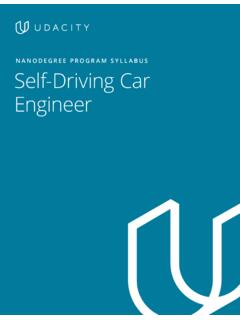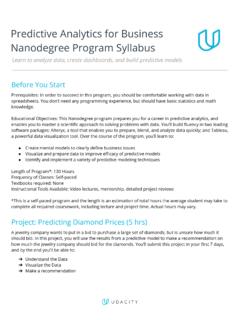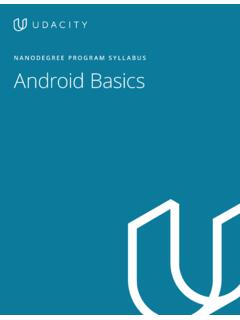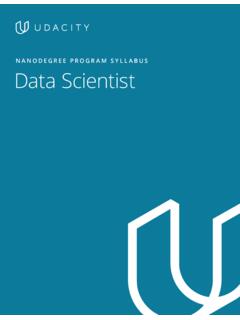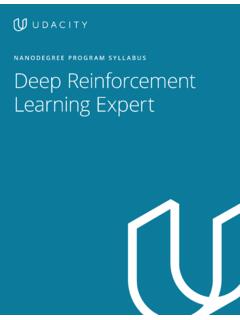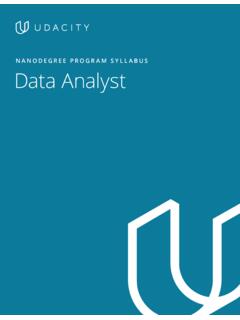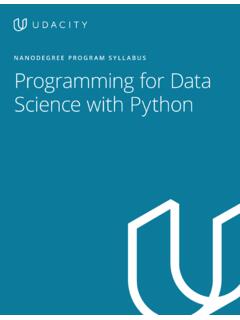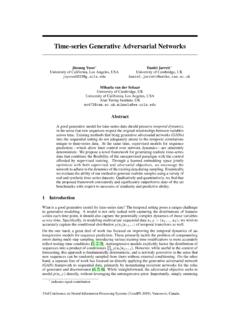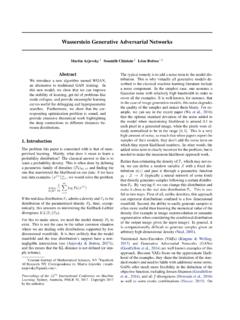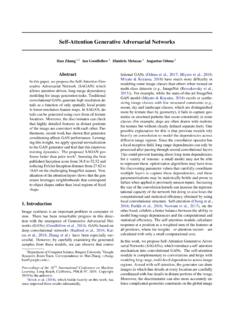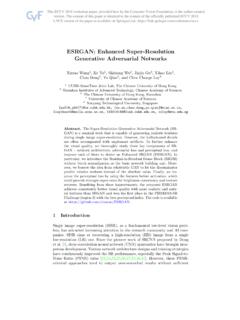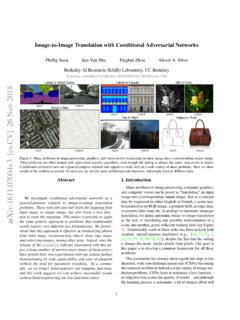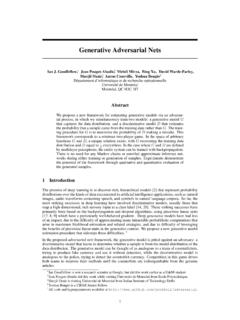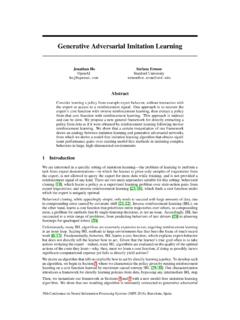Transcription of NANODEGREE PROGRAM SYLLABUS Deep Learning
1 NANODEGREE PROGRAM SyllabusDeep LearningINDIVIDUAL LEARNERSSCHOOL OF ARTIFICIAL INTELLIGENCEDeep Learning 2A graduate of this PROGRAM will be able to: Create a simple neural network (NN) using PyTorch to predict patterns from real data. Build convolutional neural networks (CNNs) to classify landmark images based on patterns and objects that appear in them. Implement a recurrent neural network (RNN) and its variants (LSTMs, GRUs) with PyTorch to build a customer service ObjectivesOverviewThe deep Learning NANODEGREE PROGRAM offers you a solid introduction to the world of artificial intelligence.
2 In this PROGRAM , you ll master fundamentals that will enable you to go further in the field or launch a brand new career. You will study cutting-edge topics such as neural networks, convolutional neural networks, recurrent neural networks, and generative adversarial networks. Plus, you ll build projects in PyTorch. Join the next generation of deep Learning talent that will help define a highly beneficial AI-powered future for our Learning 3 PROGRAM informationStudents should have experience working with and/or knowledge of the following topics.
3 Derivatives Linear Algebra Numpy, Pandas Intermediate Python Jupyter notebooksNLTK, SKLearn, BeautifulSoup, Numpy4 months at 10hrs/week*Estimated Time*The length of this PROGRAM is an estimation of total hours the average student may take to complete all required coursework, including lecture and project time. If you spend about 10 hours per week working through the PROGRAM , you should finish within the time provided. Actual hours may Hardware/SoftwareIntermediateSkill LevelDeep Learning 4 Course 1 Introduction to deep LearningThis course covers the fundamental theoretical and practical topics in deep Learning .
4 You ll begin by Learning about how experts think about deep Learning , when it is appropriate to use deep Learning , and how to apply the skill. You ll then learn the foundational algorithms underpinning modern deep Learning : gradient descent and backpropagation. Once those foundations are established, explore design constructs of neural networks and the impact of these design decisions. Finally, the course explores how neural network training can be optimized for accuracy and robustness using training techniques like early stopping, dropout, regularization, and momentum.
5 Throughout the course, theory and fundamental implementations are woven together with PyTorch code to reinforce both the theory and practice of deep a Handwritten Digits Classifier with PyTorchIn this project, you will develop a handwritten digit recognition system in PyTorch. Then, use data preprocessing skills to load data appropriately for use in models. Develop a neural network using PyTorch and write a training loop that trains the model with the loaded data. Lastly, apply advanced training techniques to improve accuracy on the test 1 deep Learning Explain the difference between artificial intelligence, machine Learning , and deep Learning .
6 Recognize the power of deep Learning by reviewing popular examples of deep Learning ProjectDeep Learning 5 Lesson 2 Minimizing the Error Function with Gradient Descent Use PyTorch to preprocess data. Use maximum likelihood, cross-entropy, and probability to measure model performance. Apply gradient descent to minimize error. Implement a backpropagation algorithm. Identify key components of 3 Introduction to Neural Networks Explain essential concepts in neural networks. Design neural network architectures.
7 Distinguish between problems based on the objective of the model. Implement appropriate architectures for model 4 Training Neural Networks Define a loss function and optimization method to train a neural network . Distinguish between overfitting and underfitting, and identify the causes of each. Optimize the training process using early stopping, regularication, dropout, Learning rate decay, and momentum. Distinguish between batch and stochastic gradient descent. Build a neural network with PyTorch and run data through it.
8 Test and validate a trained network to ensure it Learning 6 Convolutional Neural NetworksThis course introduces convolutional neural networks, the most widely used type of neural networks specialized in image processing. You will learn the main characteristics of CNNs that make them better than standard neural networks for image processing. Then you ll examine the inner workings of CNNs, including how to build CNNs from scratch to complete image classification tasks. After, you ll apply these architectures to custom datasets using transfer Learning and learn to use autoencoders for anomaly detection as well as image denoising.
9 Finally, you will learn how to use CNNs for object detection and semantic Classification and Tagging for Social MediaPhoto sharing and photo storage services like to have location data for each photo that is uploaded. With the location data, these services can build advanced features, such as automatic suggestion of relevant tags or automatic photo organization, which help provide a compelling user experience. Although a photo s location can often be obtained by looking at the photo s metadata, many photos uploaded to these services will not have location metadata available.
10 This can happen when, for example, the camera capturing the picture does not have GPS or if a photo s metadata is scrubbed due to privacy no location metadata for an image is available, one way to infer the location is to detect and classify a discernible landmark in the image. Given the large number of landmarks across the world and the immense volume of images that are uploaded to photo sharing services, using human judgment to classify these landmarks would not be this project, you will build models to automatically predict the location of the image based on any landmarks depicted in the image.
